 |
 |
 |
| |
Barriers to Effective Antenatal Hepatitis C Virus (HCV) Screening
|
| |
| |
Reported by Jules Levin
IDSA Oct 2-6 2013 San Francisco, CA
Wambui Waruingi MD Nazha Abughali MD
Department of Pediatrics, MetroHealth Medical Center , Case Western Reserve University School of Medicine, Cleveland, Ohio
Address correspondence to:
Wambui.waruingi@cchmc.org
Tel: 440-503-0729
BACKGROUND
Currently, pregnant women are routinely screened for many infections that pose a risk to the unborn fetus. For HCV, ACOG and CDC recommend screening for risk factors, and testing if present. Using this approach, the reported prevalence of HCV in pregnant women at our institution is 0.4%. We hypothesized that there are barriers to effective risk-factor based screening.
OBJECTIVE
The main objective of this study was to determine the barriers to effective risk -factor based HCV screening in pregnant women in our population.
AUTHOR CONCLUSION:
While risk-factor based screening is helpful for detecting pregnant women with HCV infection, there are still a significant number of women for whom testing is indicated, that do not get it despite the presence of risk factors. From this study, we identified screening deficiencies that were undetected risk factors and failure to test despite the presence of risk factors. We recommend increased HCV awareness and vigilance for risk factors among the OB. Universal screening may be recommended in populations where barriers to effective screening cannot be overcome.
METHODS & MATERIALS
This was an IRB approved study. Prospective HCV antibody testing of previously unscreened, consenting women in the immediate postpartum period ("low-risk" arm) was performed and compared to pregnant women screened by the obstetrician (OB) in the course of routine prenatal care based on perceived risk ("high-risk" arm) between January and March 2013. Testing in the "low-risk" mothers was done using discarded serum collected at the time of delivery. HCV testing was done using Ortho HCV 3.0 ELISA double serum testing with positive and negative controls.
Program Abstract
Background:
Background: Currently, pregnant women are routinely screened for many infections that pose a risk to the unborn fetus. For HCV, a viral infection of growing significance, ACOG and CDC recommend screening for risk factors, and testing if present. Using this approach, the reported prevalence of HCV in pregnant women at the study institution is 0.4%. We hypothesized that risk-factor based screening is not effective in all populations.
Methods: Prospective HCV antibody testing of previously unscreened, consenting women ("low-risk" arm) was performed and compared to pregnant women screened by the obstetrician (OB) in the course of routine prenatal care ("high-risk" arm) in the immediate postpartum period between January and March 2012. Demographic data and reported HCV risk factors were collected by chart review on all the women included in the study. Discarded serum on the low-risk mother was collected and HCV done using Ortho HCV 3.0 ELISA tests with positive and negative controls.
Results: 419 women delivered during the study period. Of these, 382/419 (91%) were in the "low-risk" arm, and 37/419 (9%) in the "high-risk" arm. 183/382 (48%) agreed to participate and had serum available for HCV testing. 25/183 (11%) had documented HCV risk factors in their medical chart that did not trigger testing by OB. 21/183 (11%) had a history of (h/o) drug use, 1/183 (0.5%) had abnormal liver panel in pregnancy, 1/183 (0.5%) had a partner with HCV and 3/183 (1.6%) had received a blood transfusion. 3/183 (1.6%) were HCV positive. Two had documented risk factors, one had h/o drug use, and the last had h/o blood transfusion and a partner with HCV. In the OB tested group, 4/37 (10.8%) were HCV positive.
Conclusion: While risk-factor based screening is helpful for detecting pregnant women with HCV infection, there are still a significant number of women for whom testing is indicated, that do not get it despite the presence of risk factors. We recommend increased HCV awareness and vigilance of risk factors among the OBs. Universal screening may be preferred in populations where barriers to effective screening cannot be overcome.
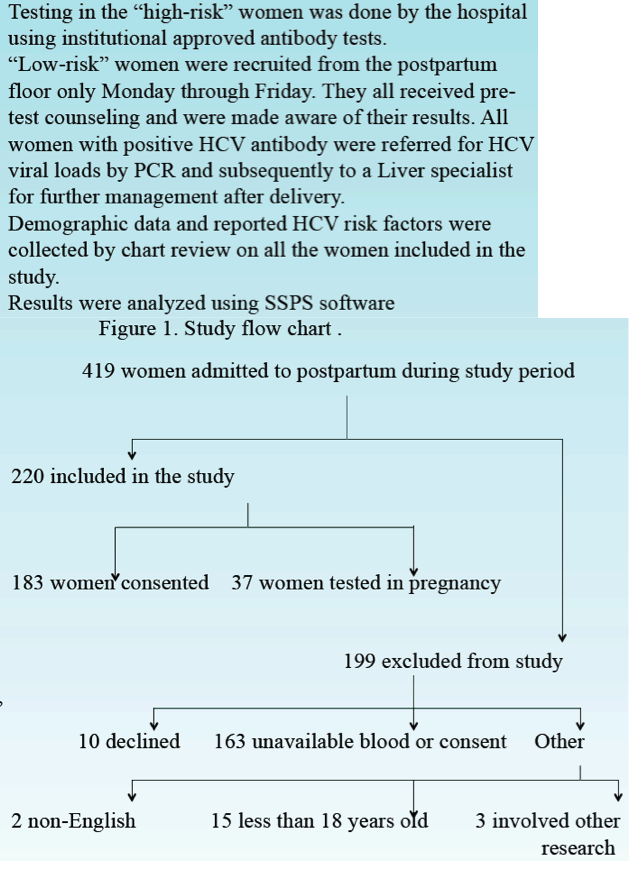
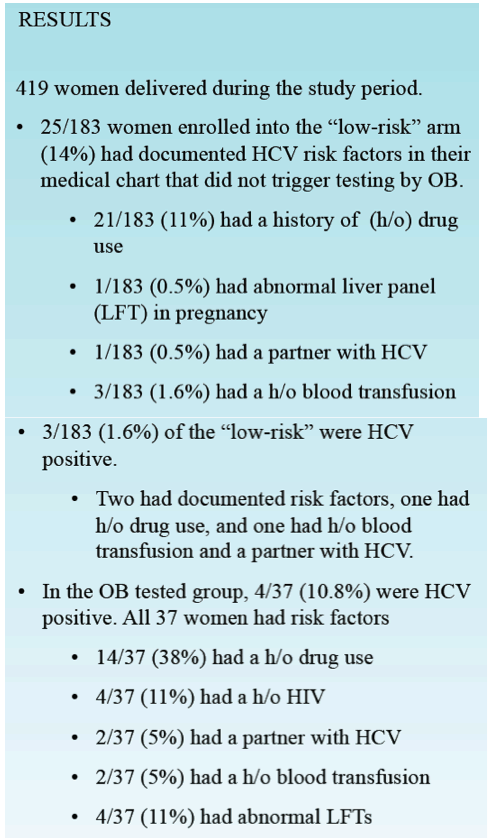
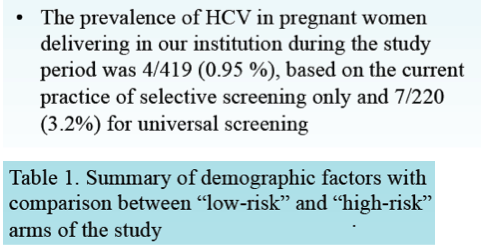
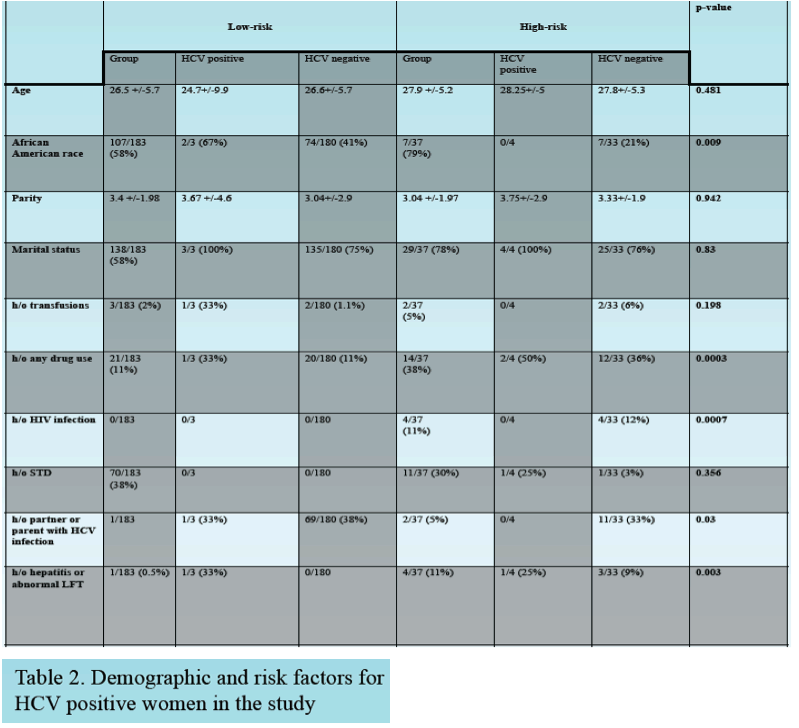
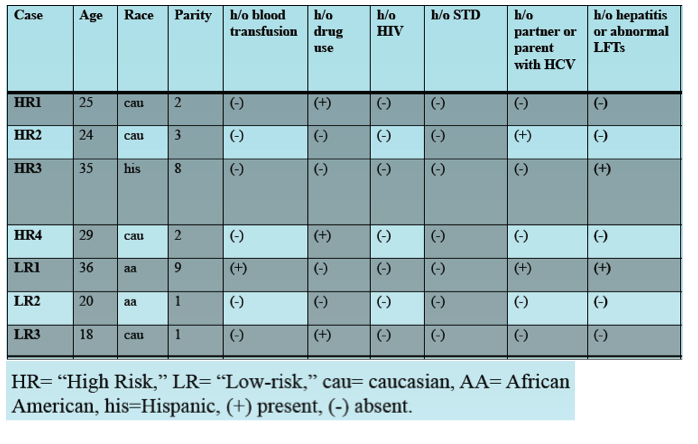
|
| |
|
 |
 |
|
|